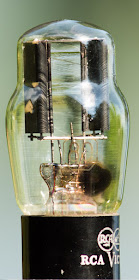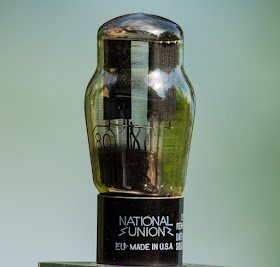Hi!
In this last post about the fully differential phonostage with D3a tubes, I am sharing some more photos, also with the unit glowing in the dark and some assessment of it's sound.
Here a photo of the phono with the power supply:
As mentioned it shares pretty much the same circuit and parts quality with the differential EC8020 phono.
The D3a tubes glowing away:
8 D3a tubes playing in unison.
So the big question: How does it sound?
This unit shares the same strengths with the EC8020 version. The absence of capacitors in the gain stages shows it's advantage by removing the last bit of grain from the sound and giving extremely revealing timbre and details.
The result is surprisingly close to the EC8020 version. So the sound descriptions given for that one are mostly valid.
The EC8020 gives a tad more resolution, ambience and decay of tones. It is for those who only accept the best of the best.
The D3a however is a close runner up at significantly less tube costs. Let's see how the ultimate version with all silver transformers and plate chokes will do. Stay tuned!
Best regards
Thomas
▼
Tuesday, July 26, 2016
Wednesday, July 20, 2016
Tube of the Month : The 80
Hi!
Let's have a look at a rectifier tube this month, the 80.
The 80 is a 'classic' full wave rectifier tube. It is directly heated.
 Thus it only needs 4 pins, 2 plates and the 2 filament connections. Which fits on a UX4 base. The pinout is shown on the left. As all the classic rectifiers it has a 5V filament which consumes 2A. It is a rather small rectifier which cannot deliver a lot of current. 135mA max when a choke inout filter is used. Less with a capacitor input filter. For all details regarding the technical specs refer to the data sheet. This rather modest current capability makes it only usable for preamplifiers or small power amps which do not draw a lot of current. A stereo 45 amplifier is about the maximum which comes to mind and that is also what I have used this tube for many years ago before I turned to TV dampers. It could also supply a mono 2A3 single ended amp.
Thus it only needs 4 pins, 2 plates and the 2 filament connections. Which fits on a UX4 base. The pinout is shown on the left. As all the classic rectifiers it has a 5V filament which consumes 2A. It is a rather small rectifier which cannot deliver a lot of current. 135mA max when a choke inout filter is used. Less with a capacitor input filter. For all details regarding the technical specs refer to the data sheet. This rather modest current capability makes it only usable for preamplifiers or small power amps which do not draw a lot of current. A stereo 45 amplifier is about the maximum which comes to mind and that is also what I have used this tube for many years ago before I turned to TV dampers. It could also supply a mono 2A3 single ended amp.
 Being a classic full wave rectifier it requires a power transformer with a center tapped high voltage winding unless it is augmented with two single diodes to create a bridge rectifier. My samples of this tube had been lying in storage since well over 10 years since the amp I used them in has been dismantled a long time ago. I pulled them out of the drawer to shoot some photos for this post. The 80 has been produced over a very long time. It started it's life in the 1920ies in globe shape as UX280. It adopted the ST shape in the 1930ies and was even packaged in the much slimmer GT tubular bulbs at the end of it's life. It was made by all the major tube manufacturers. Let's start with the gorgeous UX280 made by RCA:
Being a classic full wave rectifier it requires a power transformer with a center tapped high voltage winding unless it is augmented with two single diodes to create a bridge rectifier. My samples of this tube had been lying in storage since well over 10 years since the amp I used them in has been dismantled a long time ago. I pulled them out of the drawer to shoot some photos for this post. The 80 has been produced over a very long time. It started it's life in the 1920ies in globe shape as UX280. It adopted the ST shape in the 1930ies and was even packaged in the much slimmer GT tubular bulbs at the end of it's life. It was made by all the major tube manufacturers. Let's start with the gorgeous UX280 made by RCA:
View from another angle:
Close up to the interior:
Here the two plates and the glass stem which aligns the electrode is nicely visible:
View from the top:
Close up to the ribbon filament:
Side view:
The top with the RCA logo:
A Cunningham CX380 also made by RCA:
Detail close up:
More views:
From the top:
Glass stem:
Philco made by Sylvania:
From the side:
Close up showing the ribbon filament:
The plates:
Top:
RCA:
The top:
This one has the plates quite close to each other:
RCA-Victor:
The top:
Another RCA this time with GT straight sided bulb:
Detail close up:
Another view:
The plates look similar to those in the ST shaped RCA shown above:
The GT version is rather small compared to a ST tube:
Raytheon:
The tube with the box:
Ken-Rad:
A JAN-80 made by Sylvania for the military in sealed box:
The box also carries the VT number which in this case is 80 as well (which is not the case for all tubes and can cause confusion).
Apparently this tube was inspected in 58. Which is indicated by the stamp and sticker:
The boy was made such that the tube could be tested without breaking the sealed packaging:
The top flap could be opened.
So the tube could be pushed down a little to expose the pins for testing:
Tung-Sol:
National Union 80:
The plates:
A 80 with the filament lit up:
Close up:
The mica disc obstructs much of the view to the filaments:
Since the globe tubes don't have mica discs they give a much better view to the glow:
I hope you enjoyed this rectifier presentation.
Best regards
Thomas
Let's have a look at a rectifier tube this month, the 80.
The 80 is a 'classic' full wave rectifier tube. It is directly heated.
 Thus it only needs 4 pins, 2 plates and the 2 filament connections. Which fits on a UX4 base. The pinout is shown on the left. As all the classic rectifiers it has a 5V filament which consumes 2A. It is a rather small rectifier which cannot deliver a lot of current. 135mA max when a choke inout filter is used. Less with a capacitor input filter. For all details regarding the technical specs refer to the data sheet. This rather modest current capability makes it only usable for preamplifiers or small power amps which do not draw a lot of current. A stereo 45 amplifier is about the maximum which comes to mind and that is also what I have used this tube for many years ago before I turned to TV dampers. It could also supply a mono 2A3 single ended amp.
Thus it only needs 4 pins, 2 plates and the 2 filament connections. Which fits on a UX4 base. The pinout is shown on the left. As all the classic rectifiers it has a 5V filament which consumes 2A. It is a rather small rectifier which cannot deliver a lot of current. 135mA max when a choke inout filter is used. Less with a capacitor input filter. For all details regarding the technical specs refer to the data sheet. This rather modest current capability makes it only usable for preamplifiers or small power amps which do not draw a lot of current. A stereo 45 amplifier is about the maximum which comes to mind and that is also what I have used this tube for many years ago before I turned to TV dampers. It could also supply a mono 2A3 single ended amp. Being a classic full wave rectifier it requires a power transformer with a center tapped high voltage winding unless it is augmented with two single diodes to create a bridge rectifier. My samples of this tube had been lying in storage since well over 10 years since the amp I used them in has been dismantled a long time ago. I pulled them out of the drawer to shoot some photos for this post. The 80 has been produced over a very long time. It started it's life in the 1920ies in globe shape as UX280. It adopted the ST shape in the 1930ies and was even packaged in the much slimmer GT tubular bulbs at the end of it's life. It was made by all the major tube manufacturers. Let's start with the gorgeous UX280 made by RCA:
Being a classic full wave rectifier it requires a power transformer with a center tapped high voltage winding unless it is augmented with two single diodes to create a bridge rectifier. My samples of this tube had been lying in storage since well over 10 years since the amp I used them in has been dismantled a long time ago. I pulled them out of the drawer to shoot some photos for this post. The 80 has been produced over a very long time. It started it's life in the 1920ies in globe shape as UX280. It adopted the ST shape in the 1930ies and was even packaged in the much slimmer GT tubular bulbs at the end of it's life. It was made by all the major tube manufacturers. Let's start with the gorgeous UX280 made by RCA:View from another angle:
Close up to the interior:
Here the two plates and the glass stem which aligns the electrode is nicely visible:
View from the top:
Close up to the ribbon filament:
Side view:
The top with the RCA logo:
A Cunningham CX380 also made by RCA:
Detail close up:
More views:
From the top:
Glass stem:
Philco made by Sylvania:
From the side:
Close up showing the ribbon filament:
The plates:
Top:
RCA:
The top:
This one has the plates quite close to each other:
RCA-Victor:
The top:
Another RCA this time with GT straight sided bulb:
Detail close up:
Another view:
The plates look similar to those in the ST shaped RCA shown above:
The GT version is rather small compared to a ST tube:
Raytheon:
The tube with the box:
Ken-Rad:
A JAN-80 made by Sylvania for the military in sealed box:
The box also carries the VT number which in this case is 80 as well (which is not the case for all tubes and can cause confusion).
Apparently this tube was inspected in 58. Which is indicated by the stamp and sticker:
The boy was made such that the tube could be tested without breaking the sealed packaging:
The top flap could be opened.
So the tube could be pushed down a little to expose the pins for testing:
Tung-Sol:
National Union 80:
The plates:
A 80 with the filament lit up:
Close up:
The mica disc obstructs much of the view to the filaments:
Since the globe tubes don't have mica discs they give a much better view to the glow:
I hope you enjoyed this rectifier presentation.
Best regards
Thomas















































































